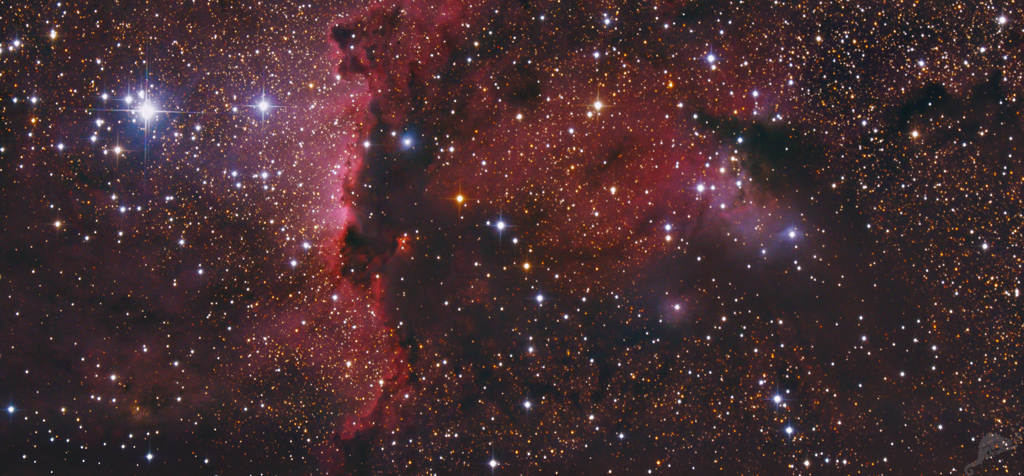 |
CHAMÄLEON + ONJALA OBSERVATORY DeepSky | SITEMAP HOME CHAMÄLEON |
|
 |
|||
| « back to overview Nebulae | Load higher resolution (1800 x 800 Pixel 3500 x 1700 Pixel) | Object description |

NGC 6193 is a very young open star cluster of the Trumpler type II 3P. It contains about 30 stars, which form the center of the star association Ara OB 1. A star association is a larger group of loosely bound stars that have not yet completely moved away from their original place of origin.
At the center of this open cluster is a pair of stars, the two blue O giants HD 150135 and HD 150136, the latter being a spectroscopic double star with a confirmed third component in an extremely eccentric orbit. Although still visible from the Earth with the naked eye, this star system is one of the most massive in our galaxy with the three components, each containing 64, 40 and 35 solar masses and shining 100,000 times brighter than our sun. The stars of NGC 6193 are very young, not older than 3 million years.
NGC 6193 has an apparent diameter in the sky of about 15 arc minutes and is located at a distance of more or less 4.200 light years from the solar system. This results in a real diameter of approx. 15 light years. The star cluster was first observed by James Dunlop in 1826.
 |
NGC 6188 (RCW 108) - associated with NGC 6193 -
is a huge star forming region, a so-called H-II region, which consists mainly
of hydrogen gas. The extremely hot O and B stars of NGC 6193 ionize the
hydrogen gas of the nebula and make it glow in a red colour. The main part of
the nebula (in the center of our image) is in the English-speaking world also
called the rim nebula because of the strong contrast between light and dark
areas. The intensive ultraviolet radiation and violent stellar winds of the
stars of NGC 6193 are decisive for the formation of many new stars in the H-II
region. Especially interesting is the small red nebula - similar to an hourglass - GN 16.36.2.02. Where in the visible light of our image just 3 stars are visible, large telescopes in infrared light can detect about 40 massive O- and B stars, which are still covered by hydrogen gas. The brightest part of the H-II region was first observed by John Herschel in 1836. « Click here or the thumbnail to load a large image with marked objects |
| Our
image shows only the central part of NGC 6188, the whole region and the bipolar
nebula NGC 6164/65 - one of the rare Wolf-Rayet stars - shows the mosaic, taken
in the year 2009 with the 6 inch refractor of the Rooisand Observatory. The
bipolar nebula lies in the constellation Norma. NGC 6164/65 was discovered by
John Herschel on July 1, 1834. » Click hereor the thumbnail to load a larger images |
 top of page |
|
|
 |
 |
 |
 |
 |
 |
 |
| Sun | Moon | Solar System | DeepSky | Widefield | Miscellaneous | Spec. Projects |
